Numerical Investigation of High-Temperature Superconducting-Coated-Conductors Subjected to Rotating Magnetic Fields
Abstract
1. Introduction
2. Model Description
2.1. H-Formulation
2.2. Rotating Magnetic Fields
3. Results and Discussion
3.1. AC Loss Analysis
3.2. Flux Density Maps
4. Conclusions
Author Contributions
Funding
Data Availability Statement
Conflicts of Interest
References
- Soomro, W.A.; Guo, Y.; Lu, H.Y.; Jin, J.X. Advancements and impediments in applications of high-temperature superconducting material. In Proceedings of the 2020 IEEE International Conference on Applied Superconductivity and Electromagnetic Devices (ASEMD), Tianjin, China, 16–18 October 2020; pp. 1–4. [Google Scholar] [CrossRef]
- Chen, M.; Donzel, L.; Lakner, M.; Paul, W. High temperature superconductors for power applications. J. Eur. Ceram. Soc. 2004, 24, 1815–1822. [Google Scholar] [CrossRef]
- Amemiya, N.; Kasai, N.; Yoda, K.; Jiang, Z.; Levin, G.A.; Barnes, P.N.; Oberly, C.E. AC loss reduction of YBCO coated conductors by multifilamentary structure. Supercond. Sci. Technol. 2004, 17, 1464–1471. [Google Scholar] [CrossRef]
- Shen, B.; Li, C.; Geng, J.; Zhang, X.; Gawith, J.; Ma, J.; Liu, Y.; Grilli, F.; Coombs, T.A. Power dissipation in HTS coated conductor coils under the simultaneous action of AC and DC currents and fields. Supercond. Sci. Technol. 2018, 31, 075005. [Google Scholar] [CrossRef]
- Majoros, M.; Ye, L.; Velichko, A.V.; Coombs, T.A.; Sumption, M.D.; Collings, E.W. Transport AC losses in YBCO coated conductors. Supercond. Sci. Technol. 2007, 20, S299–S304. [Google Scholar] [CrossRef]
- Xiao, X.; Liu, Y.; Jin, J.; Li, C.; Xu, F. HTS applied to power system: Benefits and potential analysis for energy conservation and emission reduction. IEEE Trans. Appl. Supercond. 2016, 26, 1–9. [Google Scholar] [CrossRef]
- Soomro, W.A.; Guo, Y.; Lu, H.Y.; Zhu, J.G.; Jin, J.X.; Shen, B. Numerical investigation of AC loss in HTS bulks subjected to rotating magnetic fields. In Proceedings of the 31st Australasian Universities Power Engineering Conference (AUPEC), Perth, Australia, 26–30 September 2021; pp. 1–5. [Google Scholar] [CrossRef]
- Soomro, W.A.; Guo, Y.; Lu, H.; Zhu, J.; Jin, J.; Shen, B. Three-dimensional numerical characterization of high-temperature superconductor bulks subjected to rotating magnetic fields. Energies 2022, 15, 3186. [Google Scholar] [CrossRef]
- Ainslie, M.D.; Fujishiro, H. Modelling of bulk superconductor magnetization. Supercond. Sci. Technol. 2015, 28, 053002. [Google Scholar] [CrossRef]
- Wang, Y.; Guan, X.; Dai, J. Review of AC loss measuring methods for HTS tape and unit. IEEE Trans. Appl. Supercond. 2014, 24, 1–6. [Google Scholar]
- Shen, B.; Li, J.; Geng, J.; Fu, L.; Zhang, X.; Zhang, H.; Li, C.; Grilli, F.; Coombs, T.A. Investigation of AC losses in horizontally parallel HTS tapes. Supercond. Sci. Technol. 2017, 30, 075006. [Google Scholar] [CrossRef]
- Grilli, F.; Pardo, E.; Stenvall, A.; Nguyen, D.N.; Yuan, W.; Gömöry, F. Computation of losses in HTS under the action of varying magnetic fields and currents. IEEE Trans. Appl. Supercond. 2014, 24, 78–110. [Google Scholar] [CrossRef]
- Grilli, F. Numerical modeling of HTS applications. IEEE Trans. Appl. Supercond. 2016, 26, 1–8. [Google Scholar] [CrossRef]
- Zermeno, V.M.R.; Abrahamsen, A.B.; Mijatovic, N.; Jensen, B.B.; Sørensen, M.P. Calculation of alternating current losses in stacks and coils made of second generation high temperature superconducting tapes for large scale applications. J. Appl. Phys. 2013, 114, 173901. [Google Scholar] [CrossRef]
- HTS Modelling Workgroup. Available online: http://www.htsmodelling.com (accessed on 28 July 2022).
- Lousberg, G.P.; Ausloos, M.; Geuzaine, C.; Dular, P.; Vanderbemden, P.; Vanderheyden, B. Numerical simulation of the magnetization of high-temperature superconductors: A 3D finite element method using a single time-step iteration. Supercond. Sci. Technol. 2009, 22, 055005. [Google Scholar] [CrossRef]
- Amemiya, N.; Murasawa, S.-i.; Banno, N.; Miyamoto, K. Numerical modelings of superconducting wires for AC loss calculations. Phys. C Supercond. 1998, 310, 16–29. [Google Scholar] [CrossRef]
- Escamez, G.; Sirois, F.; Lahtinen, V.; Stenvall, A.; Badel, A.; Tixador, P.; Ramdane, B.; Meunier, G.; Perrin-Bin, R.; Bruzek, C.-É. 3-D numerical modeling of AC losses in multifilamentary MgB2Wires. IEEE Trans. Appl. Supercond. 2016, 26, 1–7. [Google Scholar] [CrossRef]
- Xia, J.; Bai, H.; Lu, J.; Gavrilin, A.V.; Zhou, Y.; Weijers, H.W. Electromagnetic modeling of REBCO high field coils by the H-formulation. Supercond. Sci. Technol. 2015, 28, 125004. [Google Scholar] [CrossRef]
- Shen, B.; Grilli, F.; Coombs, T. Overview of H-formulation: A versatile tool for modeling electromagnetics in high-temperature superconductor applications. IEEE Access 2020, 8, 100403–100414. [Google Scholar] [CrossRef]
- Shen, B.; Grilli, F.; Coombs, T. Review of the AC loss computation for HTS using H formulation. Supercond. Sci. Technol. 2020, 33, 033002. [Google Scholar] [CrossRef]
- Grilli, F.; Sirois, F.; Zermeno, V.M.; Vojenčiak, M. Self-consistent modeling of the Ic of HTS devices: How accurate do models really need to be? IEEE Trans. Appl. Supercond. 2014, 24, 1–8. [Google Scholar]
- Bean, C.P. Magnetization of hard superconductors. Phys. Rev. Lett. 1962, 8, 250. [Google Scholar] [CrossRef]
- Brambilla, R.; Grilli, F.; Martini, L. Development of an edge-element model for AC loss computation of high-temperature superconductors. Supercond. Sci. Technol. 2006, 20, 16. [Google Scholar] [CrossRef]
- Chen, D.X.; Goldfarb, R.B. Kim model for magnetization of type-II superconductors. J. Appl. Phys. 1989, 66, 2489–2500. [Google Scholar] [CrossRef]
- Saint-James, D.; Gennes, P.G. Onset of superconductivity in decreasing fields. Phys. Lett. 1963, 7, 306–308. [Google Scholar] [CrossRef]
- Croitoru, M.; Shanenko, A.; Chen, Y.; Vagov, A.; Aguiar, J.A. Microscopic description of surface superconductivity. Phys. Rev. B 2020, 102, 054513. [Google Scholar] [CrossRef]
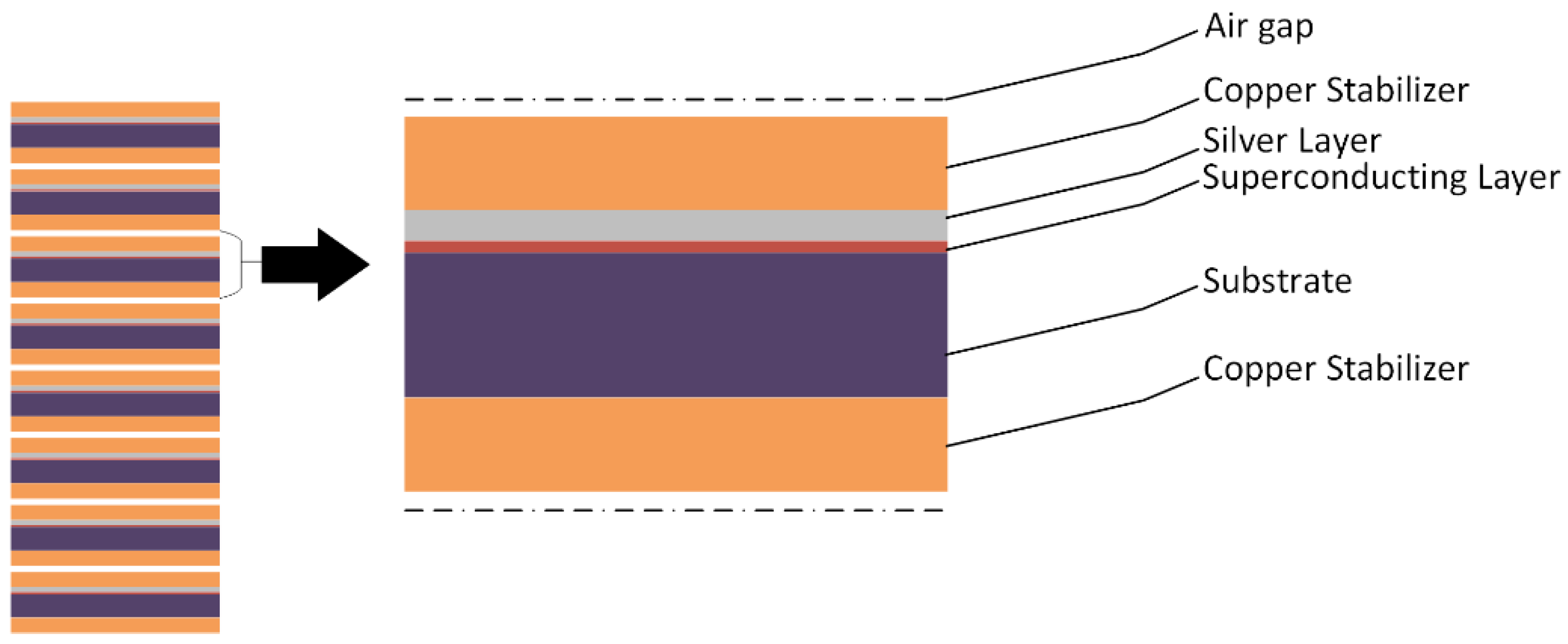

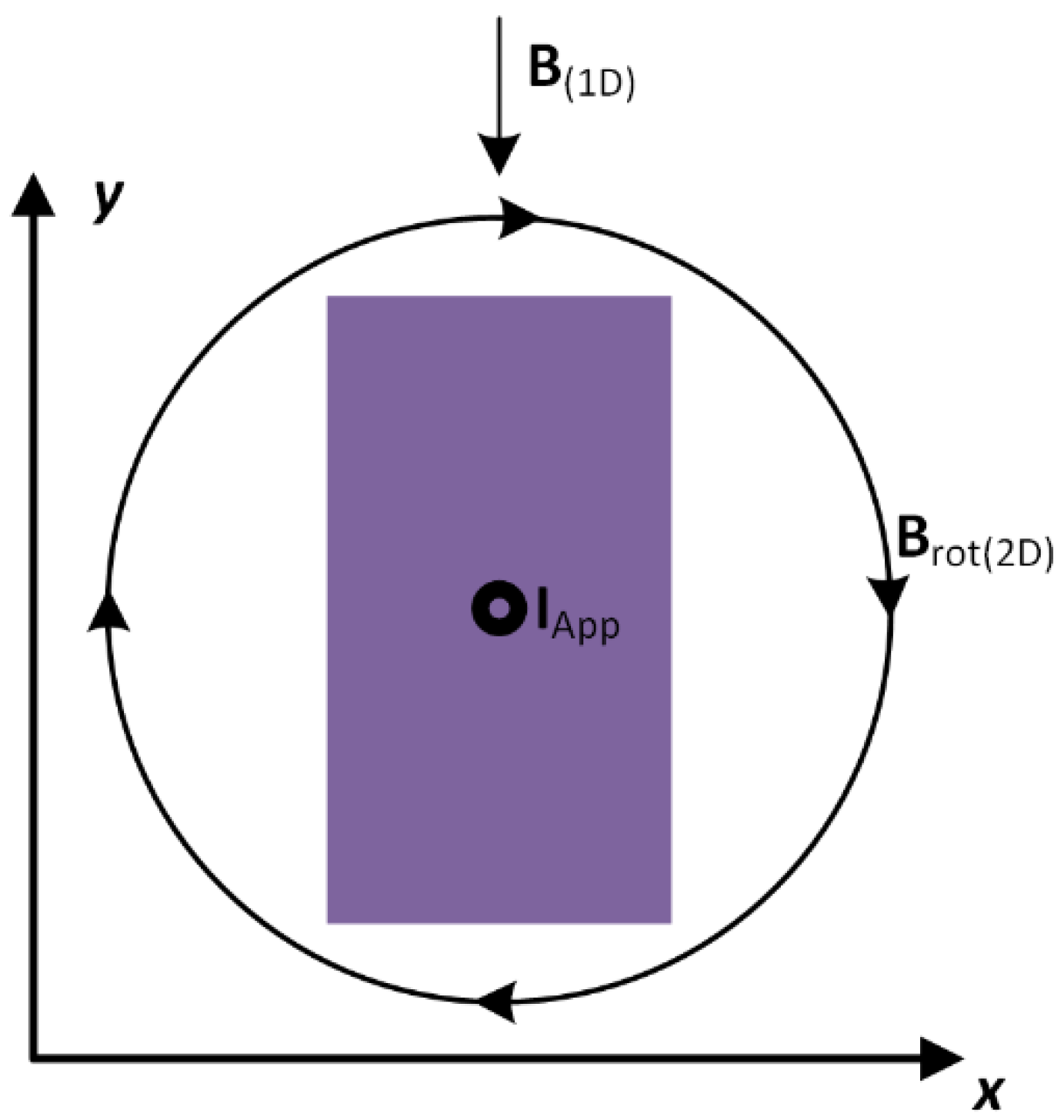
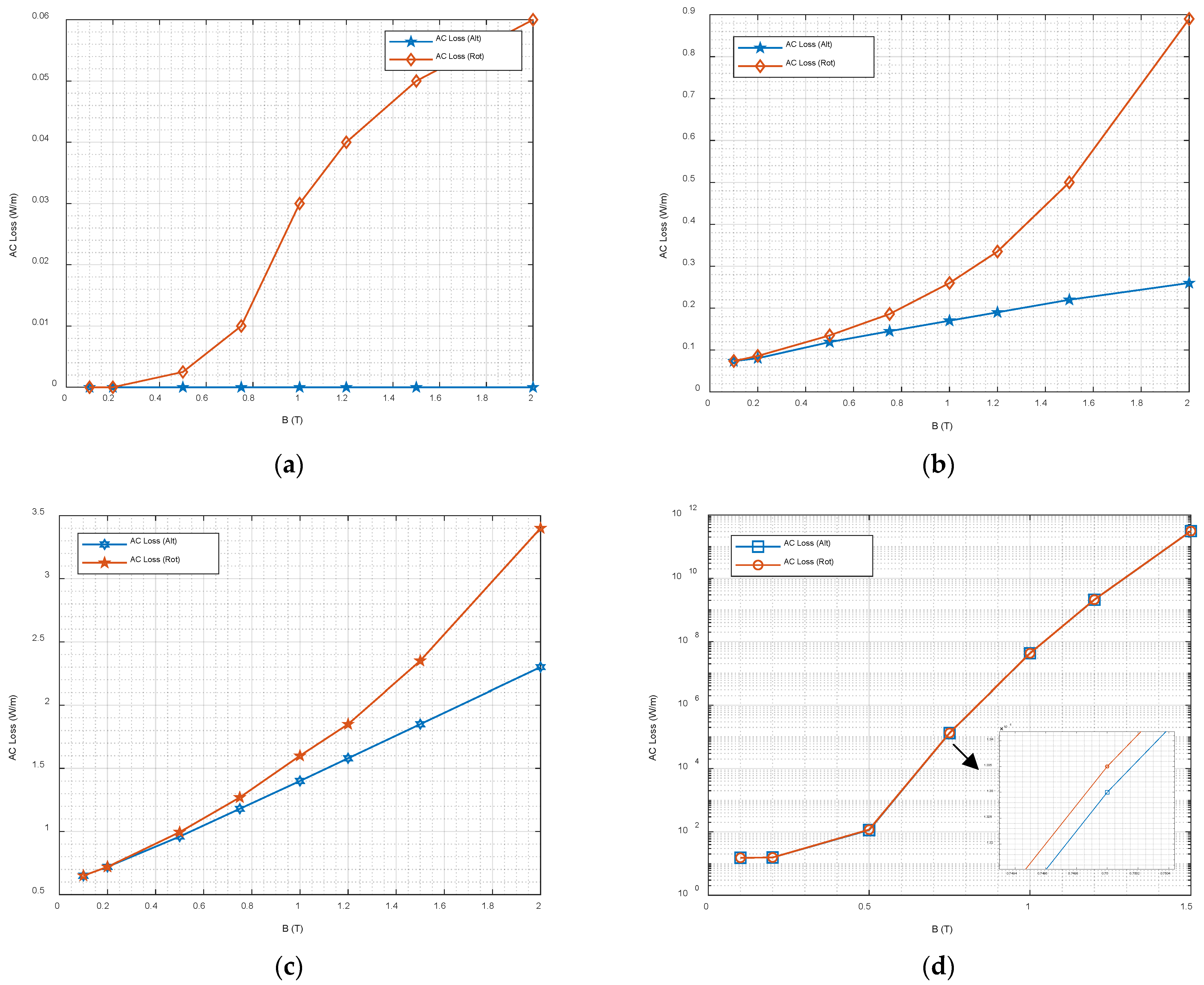
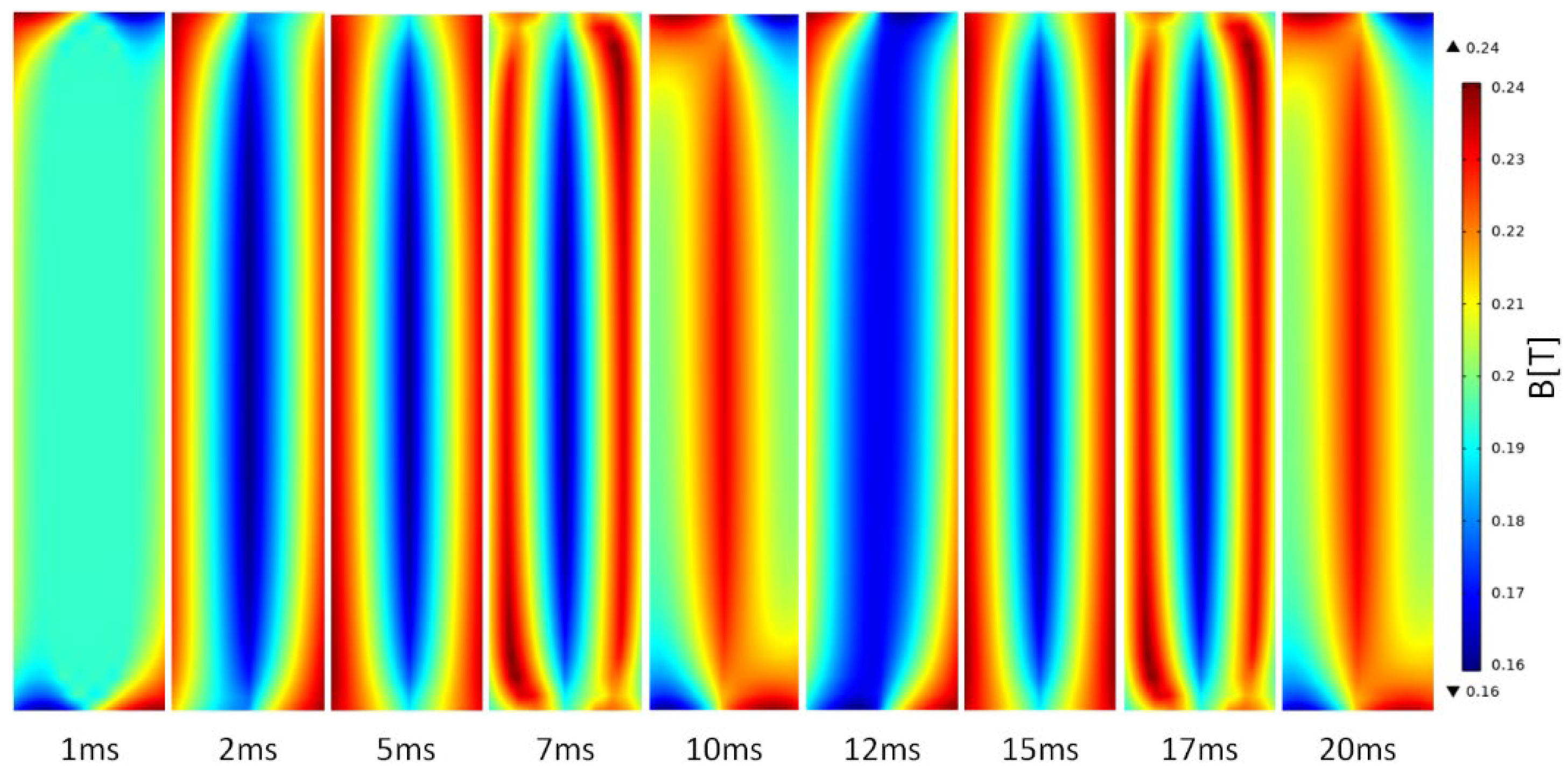
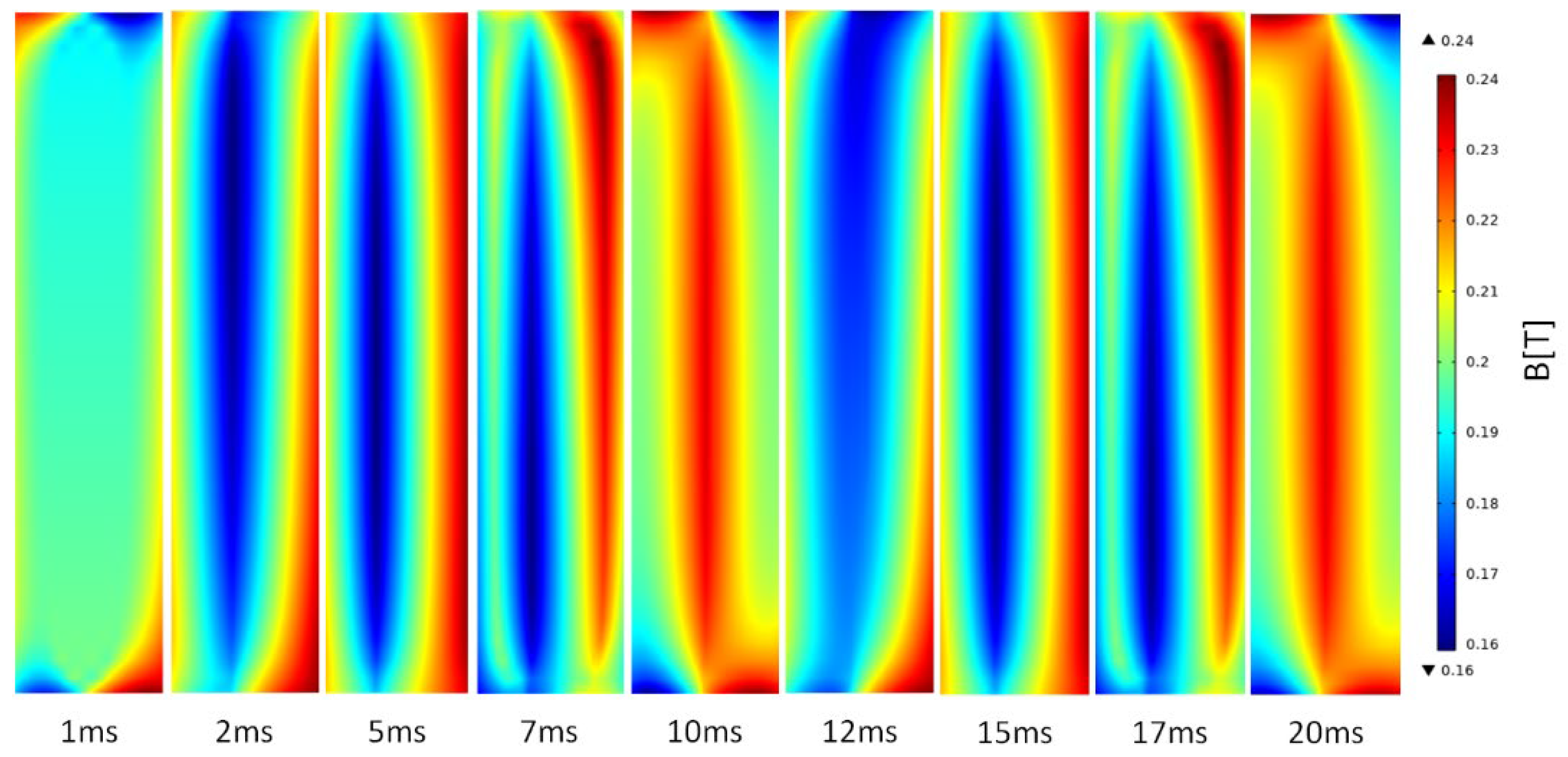
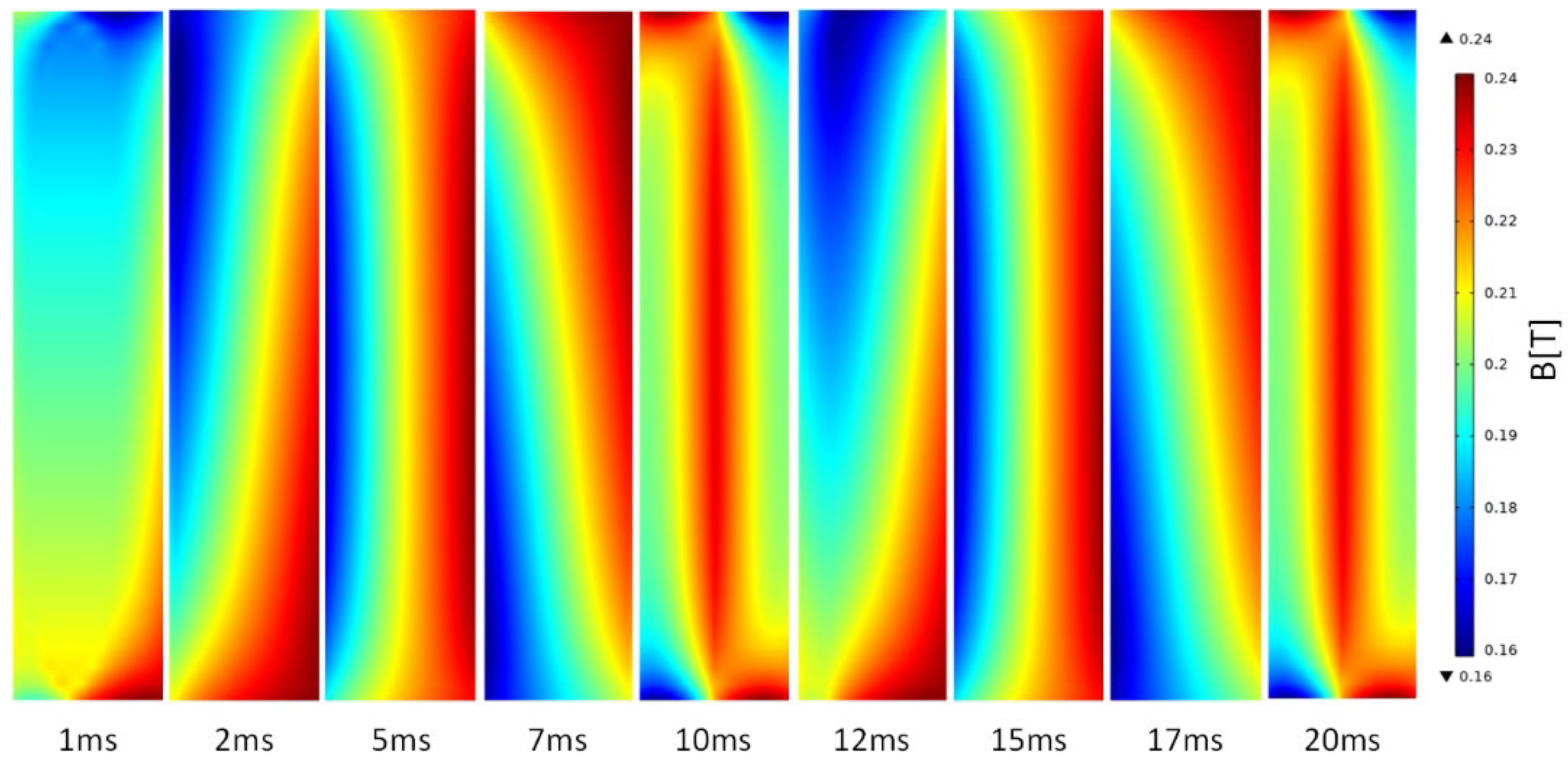
| Parameter | Symbol | Value |
|---|---|---|
| Insulation/air gap | hl | 200 µm |
| Copper layer | hcu | 40 µm |
| Substrate layer | hc | 50 µm |
| Silver layer | hag | 2 µm |
| HTS (YBCO) layer thickness | hHTS | 1 µm |
| Unit thickness | D | 293 µm |
| Tape width | a | 4 mm |
| Air/insulation resistivity | ρIns | 1 Ω·m |
| Silver resistivity | ρAg | 2.70 nΩ·m |
| Copper resistivity | ρCu | 1.97 nΩ·m |
| Substrate resistivity | ρSubs | 1.25 µΩ·m |
| Permeability of free space | μ0 | 4π × 10−7 H.m−1 |
| Number of tapes in stack | C | 64 |
| Power factor | n | 38 |
| Critical current density | Jc0 | 108 A·mm−2 |
| Characteristic electric field | E0 | 10−4 V m−1 |
| Kim’s model arbitrary parameter | B0 | 0.0041 T |
| Kim’s model arbitrary parameter | m | 0.5 |
Publisher’s Note: MDPI stays neutral with regard to jurisdictional claims in published maps and institutional affiliations. |
© 2022 by the authors. Licensee MDPI, Basel, Switzerland. This article is an open access article distributed under the terms and conditions of the Creative Commons Attribution (CC BY) license (https://creativecommons.org/licenses/by/4.0/).
Share and Cite
Soomro, W.A.; Guo, Y.; Lu, H.; Jin, J.; Shen, B.; Zhu, J. Numerical Investigation of High-Temperature Superconducting-Coated-Conductors Subjected to Rotating Magnetic Fields. Solids 2022, 3, 569-577. https://doi.org/10.3390/solids3040036
Soomro WA, Guo Y, Lu H, Jin J, Shen B, Zhu J. Numerical Investigation of High-Temperature Superconducting-Coated-Conductors Subjected to Rotating Magnetic Fields. Solids. 2022; 3(4):569-577. https://doi.org/10.3390/solids3040036
Chicago/Turabian StyleSoomro, Wafa Ali, Youguang Guo, Haiyan Lu, Jianxun Jin, Boyang Shen, and Jianguo Zhu. 2022. "Numerical Investigation of High-Temperature Superconducting-Coated-Conductors Subjected to Rotating Magnetic Fields" Solids 3, no. 4: 569-577. https://doi.org/10.3390/solids3040036
APA StyleSoomro, W. A., Guo, Y., Lu, H., Jin, J., Shen, B., & Zhu, J. (2022). Numerical Investigation of High-Temperature Superconducting-Coated-Conductors Subjected to Rotating Magnetic Fields. Solids, 3(4), 569-577. https://doi.org/10.3390/solids3040036









